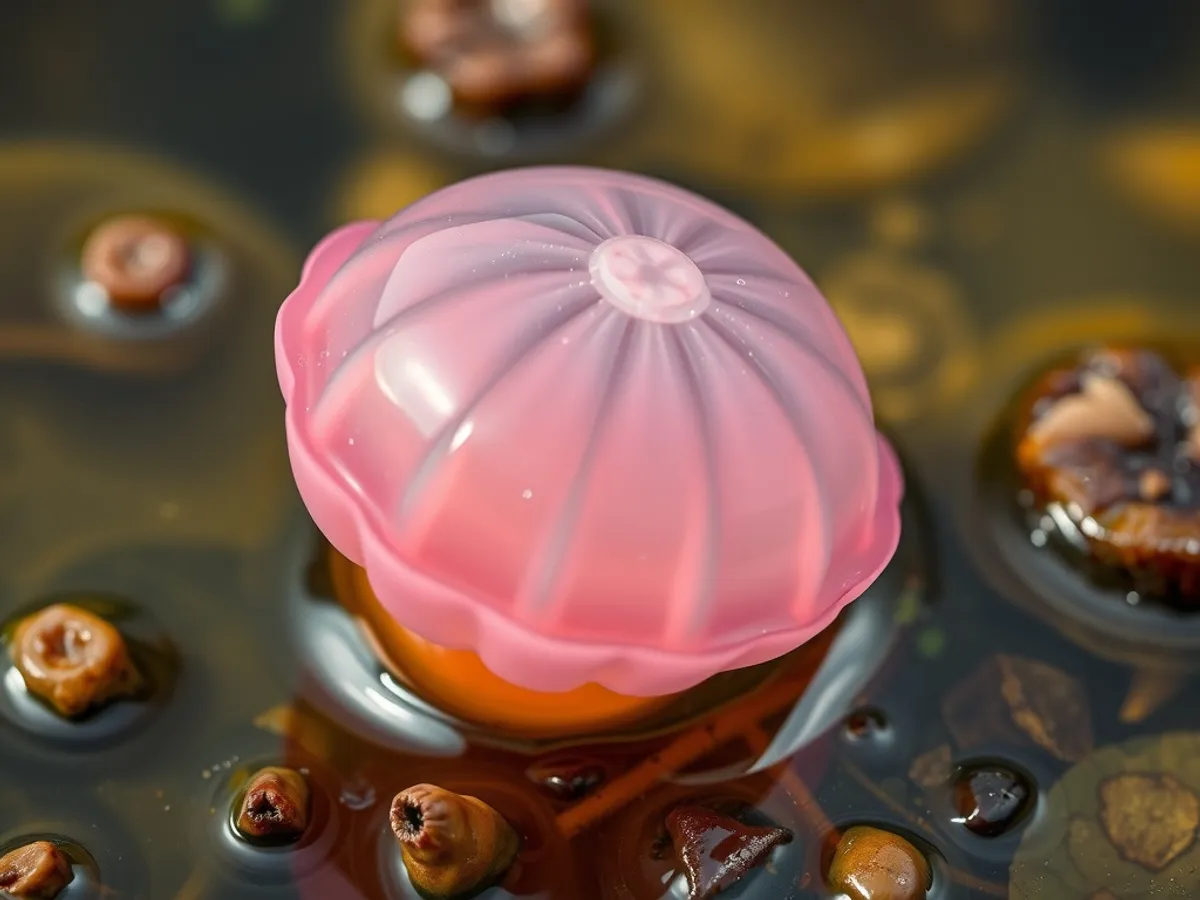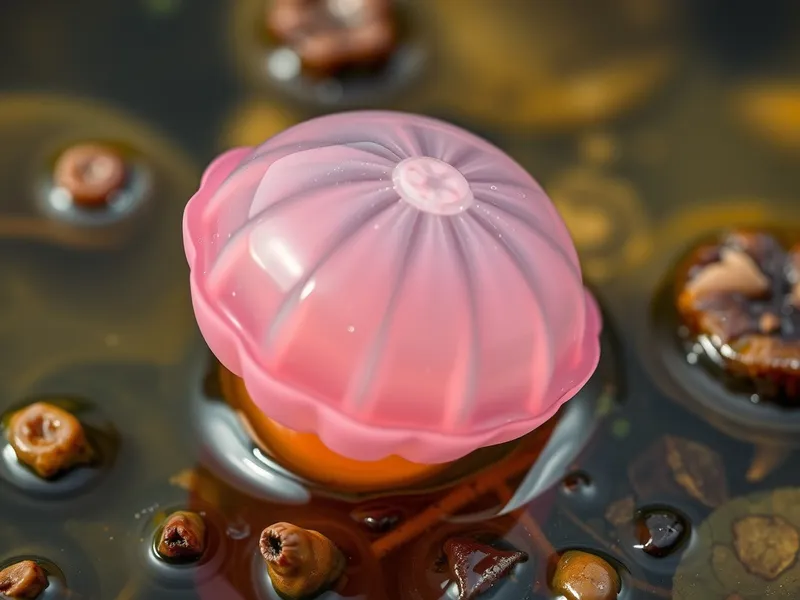
Peach Blossom Jelly
Craspedacusta sowerbii

Meet the Peach Blossom Jelly
The Peach Blossom Jelly, scientifically known as Craspedacusta sowerbii, is a small, transparent freshwater jellyfish with a delicate, umbrella-shaped bell often tinged with a pale peach or pink hue. Native originally to the Yangtze River basin in China, it has become a cosmopolitan species, now found in freshwater lakes, ponds, and reservoirs worldwide. Despite its jellyfish appearance, it poses no threat to humans, as its stings are extremely mild and rarely felt. This species typically appears in large numbers during warm months, especially in still or slow-moving waters. Its ethereal presence and sudden blooms make it a fascinating subject for both scientists and nature enthusiasts.
Classification
Invertebrate
Habitat
Freshwater lakes and ponds
Diet
Carnivore
Lifespan
Several months to 1 year
Conservation
Least Concern
Weight
Up to 4 grams
📖Fascinating Facts
Blossom-Like Appearance
The Peach Blossom Jelly gets its name from its delicate, translucent bell that often displays a pinkish or peach hue, resembling a flower in bloom.
Freshwater Habitat
Unlike most jellyfish, Peach Blossom Jellies thrive exclusively in freshwater environments such as lakes, ponds, and reservoirs.
Global Invasion
Originally from China, Craspedacusta sowerbii has spread across every continent except Antarctica, largely due to human activity and aquatic plant trade.
📋Detailed Description
Craspedacusta sowerbii, commonly known as the Peach Blossom Jelly, is a hydrozoan cnidarian distinguished by its delicate, translucent bell, which typically measures 10–25 mm in diameter. The bell is hemispherical, with a faint peach or pink tint, and is edged with 200–400 short, fine tentacles equipped with nematocysts for prey capture. The central manubrium bears four long oral arms that aid in feeding. Unlike marine jellyfish, C. sowerbii is exclusively freshwater and lacks a true medusa stage for most of its lifecycle, alternating between a sessile polyp and a free-swimming medusa. The medusae are most often observed during late summer and early autumn, coinciding with optimal water temperatures (above 25°C). The species is solitary, with no evidence of coordinated group behavior, though mass blooms may occur under favorable conditions. Its transparency and small size make it difficult to detect except during blooms. The Peach Blossom Jelly is an opportunistic carnivore, preying on zooplankton such as copepods, cladocerans, and small insect larvae. Its life cycle is complex, involving both sexual and asexual reproduction, which contributes to its invasive success in diverse freshwater habitats. The species is remarkably adaptable, tolerating a wide range of water chemistries and temperatures, which has facilitated its spread to every continent except Antarctica.
💡 Did you know?
Peach Blossom Jellyfish are among the only freshwater jellyfish species in the world, with most of their relatives living exclusively in marine environments.
🔬Research & Sources
🎭Behavior & Social Structure
Craspedacusta sowerbii exhibits a largely solitary lifestyle, with individuals drifting passively in the water column. The medusa stage is non-aggressive and relies on rhythmic pulsations of the bell for locomotion, allowing it to move vertically and horizontally in search of prey. Feeding occurs primarily at night or in low-light conditions, when zooplankton are most abundant near the surface. The tentacles are extended to capture prey, which are immobilized by nematocysts and transported to the mouth via the oral arms. There is no evidence of social behavior or communication among individuals. Daily activity patterns are influenced by water temperature and prey availability, with medusae often aggregating in warmer, sunlit surface waters during the day. The polyp stage is sessile, attaching to submerged vegetation or hard substrates, and reproduces asexually by budding.
👶Reproduction & Life Cycle
Craspedacusta sowerbii has a complex life cycle involving both sexual and asexual reproduction. The polyp stage reproduces asexually by budding, producing new polyps or medusae under favorable environmental conditions. The medusa stage is dioecious, with separate male and female individuals releasing gametes into the water column for external fertilization. Fertilized eggs develop into planula larvae, which settle and transform into new polyps. There is no parental care at any stage. Medusae are typically produced in late summer when water temperatures exceed 25°C, and blooms are often short-lived, lasting several weeks. The ability to reproduce both sexually and asexually allows rapid population expansion and colonization of new habitats.
🛡️Adaptations & Survival
Craspedacusta sowerbii possesses several adaptations for survival in freshwater environments. Its small, transparent body reduces predation risk and aids in stealthy predation. The abundance of tentacles equipped with nematocysts allows efficient capture of small, fast-moving prey. The species' ability to switch between polyp and medusa stages enables it to survive unfavorable conditions, as polyps can persist for years in a dormant state. Asexual reproduction through budding ensures rapid population growth when conditions improve. The medusa's tolerance for a wide range of temperatures (from 10°C to over 30°C) and water chemistries has facilitated its global spread. Additionally, the species can survive periods of low food availability by reverting to the polyp stage or reducing metabolic activity.
📚Research Sources
🎨Cultural Significance
The Peach Blossom Jelly has limited direct cultural significance but is occasionally featured in public aquaria and educational programs due to its ethereal appearance and unique life cycle. In China, where it was first described, it is sometimes referenced in natural history literature as an example of freshwater biodiversity. Its sudden blooms have inspired local folklore in some regions, often being associated with good fortune or the arrival of warm weather. There are no known traditional uses or symbolic roles in major cultural traditions.
🔬Recent Research & Discoveries
Recent research has focused on the invasive potential of Craspedacusta sowerbii, with studies examining its genetic diversity, dispersal mechanisms, and ecological impacts. Molecular analyses have revealed low genetic differentiation among global populations, suggesting frequent human-mediated dispersal. Ongoing research is investigating the effects of climate change on bloom frequency and distribution, as well as the potential for competition with native zooplanktivores. Studies have also explored the physiology of its nematocysts and the molecular basis of its temperature tolerance. The species serves as a model organism for understanding the evolution of life cycles in hydrozoans.
🎥Wildlife Videos

Guess The Animal By Emoji | Animal Emoji Quiz
Guess The Animal By Emoji | Animal Emoji Quiz Guess the animal by emoji! Test your knowledge with this animal challenge!
Quiz Shiba

Fruit trees - 4K Video Ultra hd | Fruit | Amazing Farm Showing Fruit
Fruit trees - 4K Video Ultra hd | Fruit | Amazing Farm Showing Fruit.
Wild Gravity 4K Video

Grape Harvesting and Prepare OLD FASHIONED GRAPE JAM
Dear friends, today we would like to share with you the Organic Grape Harvesting and Prepare OLD FASHIONED GRAPE JAMS ...
Kənd Həyatı

How do Tupelo Trees and Crawfish Help Apalachicola Bay?
We venture into floodplain swamps with the new Apalachicola Riverkeeper, mucking around to find the connection between ...
WFSU Ecology

The Life Cycle Of A Jellyfish
Did You Know? Jellyfish don't have a brain, a heart, any bones, or any eyes. They have a smooth body that looks like a bag and ...
Digit Nerd HTv

Paint My House Challenge By Multi DO
Hi all! Hurry up to start a new interesting challenge! Be sure to share it with your friends! And don't forget to subscribe to our ...
Multi DO
🌍Habitat Information
The Peach Blossom Jelly typically inhabits Freshwater lakes and ponds environments. Peach Blossom Jellys have adapted to their environments with specialized features and behaviors.
Primary Habitat:
Freshwater lakes and ponds
More detailed habitat information will be available soon.
🛡️Conservation Status
The Peach Blossom Jelly is currently classified as Least Concern. Conservation efforts are crucial for preserving this species for future generations.
Common Threats:
- 🏠Habitat loss and fragmentation
- 🌡️Climate change impacts
- 🎯Hunting and poaching
- 🏭Human-wildlife conflict
⚠️Threats & Conservation Challenges
Currently, Craspedacusta sowerbii faces few natural threats due to its adaptability and lack of specialized predators in many introduced habitats. However, rapid changes in water quality, such as pollution, eutrophication, or drastic temperature fluctuations, can negatively impact local populations. Human activities, including the movement of aquatic plants and equipment, have facilitated its spread, but there is little evidence of significant ecological harm caused by this species. Population trends are generally stable, and the species is not considered threatened. However, in some regions, dense blooms may compete with native zooplanktivores, potentially altering local food webs.
🔬Scientific Classification
Scientific Name
Craspedacusta sowerbii
Classification Hierarchy
🔍 About Taxonomic Classification
Taxonomic classification is a hierarchical system used by scientists to classify and organize living organisms based on shared characteristics and evolutionary relationships.
The system moves from broad categories (Kingdom) to increasingly specific ones, with each animal's scientific name typically consisting of its Genus and species.
📝Community Notes
Share your observations and insights about the Peach Blossom Jelly with our community of wildlife enthusiasts.
Join Our Community
Sign in to share your observations and connect with fellow wildlife enthusiasts.
Sign In to ContributeNo community notes yet
Be the first to share your observations about the Peach Blossom Jelly!
Explore Peach Blossom Jelly
Select a tab above to learn more about this amazing animal.
📸Photo Gallery
No photos available for this animal yet.
🌟Discover More Wildlife
Continue your journey of discovery with more fascinating animals from our database
